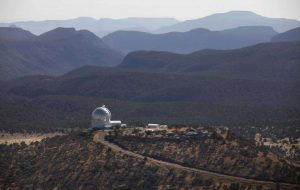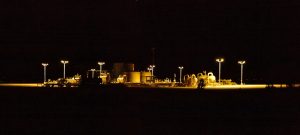
The famous University of Texas at Austin’s McDonald Observatory located in far West Texas has joined forces with oil and gas groups in the Permian Basin to make sure lights from drilling rigs don’t affect the night sky and the ability of the Observatory to see it.
The observatory made the deal with the Permian Basin Petroleum Association and the Texas Oil and Gas Association. Too much light at night drowns out the light from starts and galaxies and threatens the effectiveness of the observatory’s research telescopes used in the study of the universe.
“This partnership of PBPA and TXOGA with McDonald Observatory to protect dark skies in its vicinity is vital to the research of the universe taking place at McDonald,” said Taft Armandroff, director of the observatory.
The observatory is located in the Davis mountains not far from Fort Davis, Texas.

The collaboration’s “Recommended Lighting Practices” document details best lighting practices for drilling rigs and other oilfield structures, including what types of lighting work best and how to reduce glare and improve visibility. These practices will increase the amount of light shining down on worksites, thus increasing safety while decreasing the amount of light pollution in the sky. Reducing excess light helps the observatory and also decreases electricity costs for the oil and gas producers.
The document specifically targets oil and gas operations in the seven counties with existing outdoor lighting ordinances surrounding the McDonald Observatory: Brewster, Culberson, Hudspeth, Jeff Davis, Pecos, Presidio and Reeves. However, the recommendations can be beneficial across the industry.
“For years, the PBPA and the McDonald Observatory have worked together on educating members of the Permian Basin oil and gas community about the Dark Skies Initiative and the possible impact lighting practices can have on the observatory’s work,” said PBPA President Ben Shepperd. “About two years ago, the PBPA board of directors agreed to support the creation of lighting recommendations. We decided a great way to educate members of the industry on how they could provide a positive impact on this issue was through the utilization of such recommended practices.
“So we began work with the observatory to publish recommended lighting practices and have since worked to educate our members and those outside the oil and gas industry on the recommendations through presentations, seminars, articles in magazines and newspapers, and even one-on-one conversations,” Shepperd said.
Recently, the Texas Oil and Gas Association joined the collaboration.
“The Texas Oil and Gas Association recognizes that production practices and protecting the environment are in no way mutually exclusive,” TXOGA President Todd Staples said. “The Recommended Lighting Practices collaborative effort allows for the oil and natural gas industry to continue the work vital to our economy and our future, and for the simultaneous reduction to our ecological footprint.”





